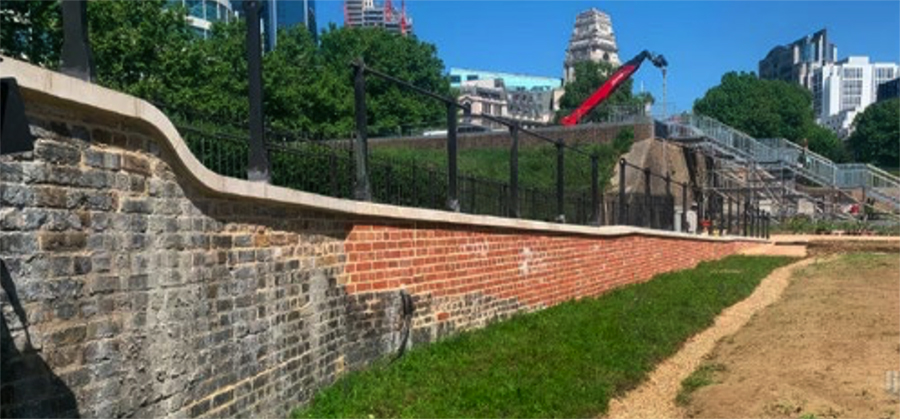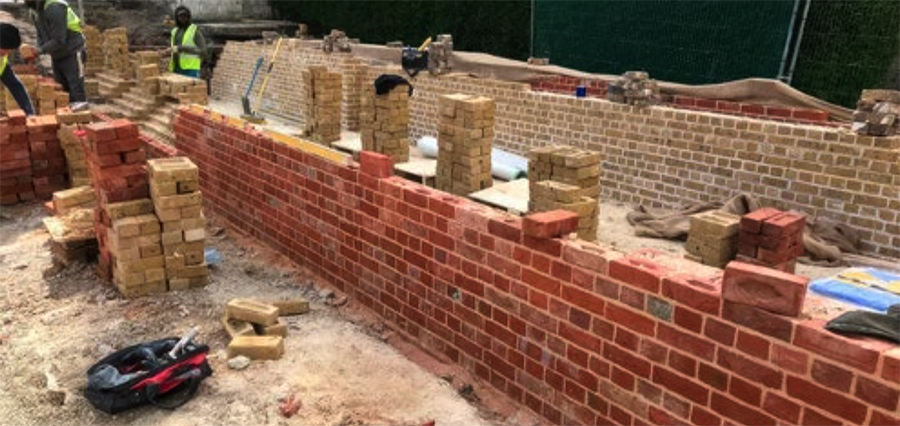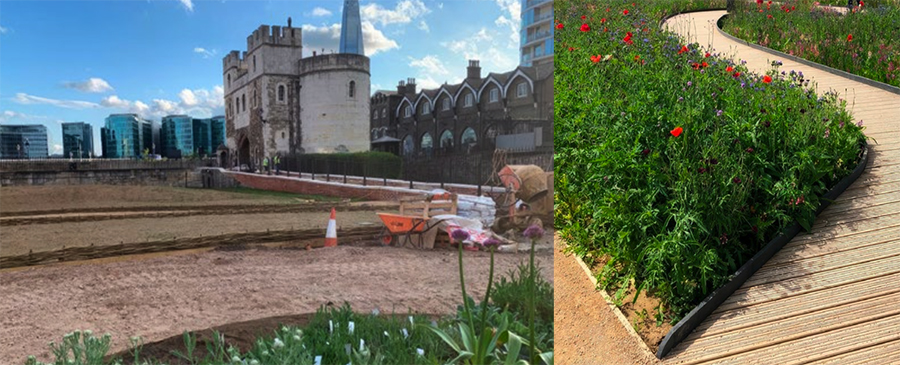The Tower of London preserved with lime mortar
Contents |
[edit] Superbloom
Superbloom is a natural new landscape surrounding the Tower of London. For the first time, earlier this year, visitors were able to walk through the moat and admire the twenty million flowers that filled and transformed the Tower’s moat.
To support visitors in accessing this area and the tower’s moat, a new ramp was needed.
“We were asked to supply labour and the material for the construction of a new access ramp into the moat,” explains Richard Flegg, Managing Director, Kent Conservation & Restoration. “The total number of bricks needed for the project was between 30,000 to 40,000, which we laid with a premixed lime mortar from Lime Green.”
The length of the ramp allowed visitors to descend into the depth of the moat below, offering an accessible route for the spectacle’s thousands of visitors.
[edit] Finding the matching product
The Tower of London, like many other historic buildings, used lime mortar in its original construction.
“We knew that preserving the history of the building, as well as the nature of the building, would be a challenge,” comments Derek March, Managing Director, Brick & Lime Supplies.
“We were given the analysis of the original mortar to spec, so the mortar we used would be as close to the original as possible. For this, we sent analysis to Lime Green, who quickly produced a sample that we then supplied to our contractor, who was happy with the match. Lime Green’s hydraulic lime mortar matched the original tested specification perfectly, and considering the size of this project, it was great that mortar was supplied in tonne bags. This made it easier for us to handle less units, and we could carry out the work much more easily.”
[edit] The right strength for the job
“As well as the colour of mortar, we needed to find the right strength and right aggregates,” continues Derek. “If you think of the Tower of London, it is a world heritage site built in 1066, so it was extremely important that everything was done accurately. Lime Green’s mixing and computer-generated programmes that evaluate the strength prediction performances of various lime mortar meant we could ensure this was the right product before we began.”
[edit] A straightforward product
“There are challenges in any construction project, from delays to general account issues, but it is always good to have a quality product you can rely on to make the project go smoothly,” comments Richard. “Thanks to the main contractor for working with us to get all of the materials into to the moat using their machinery, it was not a difficult job.”
“Lime Green provides good quality hydraulic lime mortar, which I have tried and tested for 20 years, and I have never had any issues or problems with the product,” concludes Richard.
“The Tower of London is a prestigious landmark building, and we wanted high-quality, long-lasting products from a reliable supplier,” comments Derek. “We love working with them because they are so innovative, and we really do feel privileged to work with the team on such great projects.” Lime Green has been a key supplier for other heritage projects, such as Shakespeare’s Globe Theatre. It is known for promoting the various uses of lime in building work, which stands the test of time.
“It was a pleasure to see our Hydraulic Lime Mortar used on such a prestigious project, and we absolutely love to see so many projects using lime products. We have loved working with Richard and Derek on the Tower of London Superbloom moat project, and we cannot wait to work with them again,” expresses Simon Ayres, co- founder and Managing Director, Lime Green Products.
This article appears in the CIAT AT Journal, Spring issue number 145 in the article "Preserving the Tower of London’s heritage using lime mortar".
--CIAT
[edit] Related articles on Designing Buildings
- Basic brickwork replacement.
- Defects in brickwork.
- Dismantling of bricks for reuse.
- High lime low alkali glass.
- Hot-mixed mortars: the new lime revival.
- Hydraulic lime.
- Hydrated lime.
- Lime concrete.
- Lime mortar.
- Lime plaster.
- Lime run-off.
- Mortar.
- Non hydraulic lime.
- Pointing.
- Putty lime.
- Soda-lime glass.
- Spalling.
- Specifying brick.
- The influence of geology on English brickmaking,
- The use of lime mortar in building conservation.
- Types of brick bonding.
- Types of bricks.
Featured articles and news
RTPI leader to become new CIOB Chief Executive Officer
Dr Victoria Hills MRTPI, FICE to take over after Caroline Gumble’s departure.
Social and affordable housing, a long term plan for delivery
The “Delivering a Decade of Renewal for Social and Affordable Housing” strategy sets out future path.
A change to adoptive architecture
Effects of global weather warming on architectural detailing, material choice and human interaction.
The proposed publicly owned and backed subsidiary of Homes England, to facilitate new homes.
How big is the problem and what can we do to mitigate the effects?
Overheating guidance and tools for building designers
A number of cool guides to help with the heat.
The UK's Modern Industrial Strategy: A 10 year plan
Previous consultation criticism, current key elements and general support with some persisting reservations.
Building Safety Regulator reforms
New roles, new staff and a new fast track service pave the way for a single construction regulator.
Architectural Technologist CPDs and Communications
CIAT CPD… and how you can do it!
Cooling centres and cool spaces
Managing extreme heat in cities by directing the public to places for heat stress relief and water sources.
Winter gardens: A brief history and warm variations
Extending the season with glass in different forms and terms.
Restoring Great Yarmouth's Winter Gardens
Transforming one of the least sustainable constructions imaginable.
Construction Skills Mission Board launch sector drive
Newly formed government and industry collaboration set strategy for recruiting an additional 100,000 construction workers a year.
New Architects Code comes into effect in September 2025
ARB Architects Code of Conduct and Practice available with ongoing consultation regarding guidance.
Welsh Skills Body (Medr) launches ambitious plan
The new skills body brings together funding and regulation of tertiary education and research for the devolved nation.
Paul Gandy FCIOB announced as next CIOB President
Former Tilbury Douglas CEO takes helm.
UK Infrastructure: A 10 Year Strategy. In brief with reactions
With the National Infrastructure and Service Transformation Authority (NISTA).




























Comments
[edit] To make a comment about this article, click 'Add a comment' above. Separate your comments from any existing comments by inserting a horizontal line.